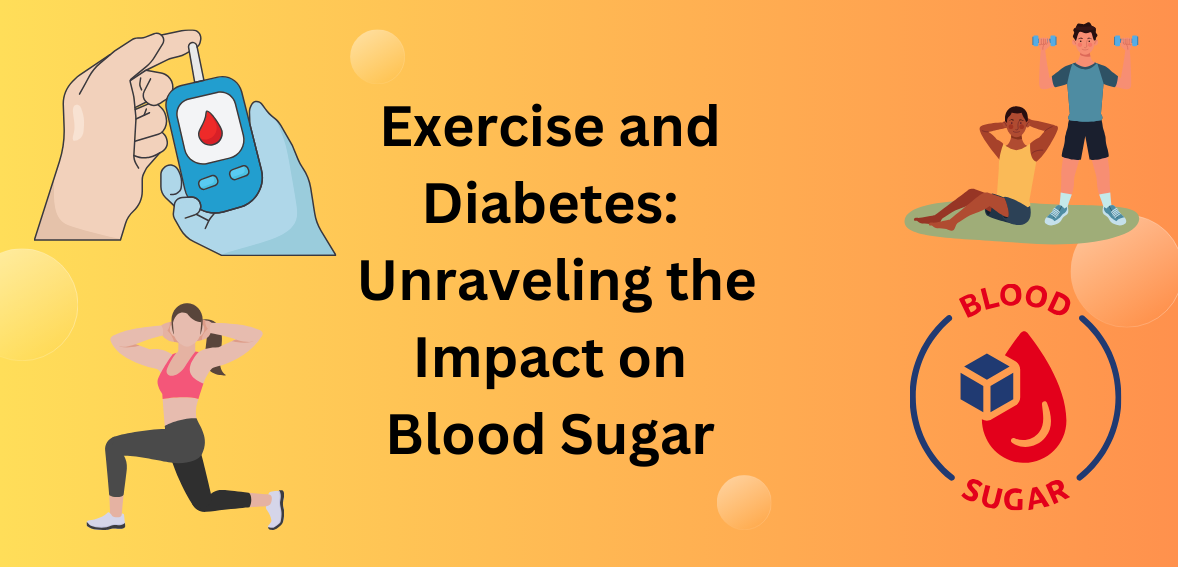Have you ever wondered how exercise affects your blood sugar levels? It’s a fascinating connection that can have a significant impact on your overall health, especially if you are managing diabetes or insulin resistance. While many people associate exercise with lowering blood sugar, there are instances when it can increase it! In this blog post, we will explore the relationship between exercise and blood sugar levels, uncover factors that influence these responses, discuss the importance of monitoring blood sugar during physical activity, and provide tips for exercising safely with diabetes or insulin resistance. So grab your workout gear and let’s dive into the world of exercise-induced changes in blood sugar levels!
How Exercise Affects Blood Sugar Levels
Regular exercise can have a significant impact on blood sugar levels, especially for individuals with diabetes or insulin resistance. When you engage in physical activity, your muscles require energy to perform the movements. To meet this demand, your body increases its uptake and utilization of glucose from the bloodstream.
During exercise, your muscles become more sensitive to insulin, the hormone responsible for transporting glucose into cells. This increased sensitivity allows cells to take up glucose more efficiently, which helps lower blood sugar levels. Additionally, physical activity stimulates muscle contractions that activate special proteins called GLUT4 transporters. These proteins facilitate the movement of glucose into muscle cells independent of insulin.
The effects of exercise on blood sugar levels can vary depending on various factors such as duration and intensity of the activity performed. Generally speaking, moderate-intensity exercises like brisk walking or cycling tend to have a gradual impact on blood sugar levels over a longer period compared to high-intensity workouts.
Individuals with diabetes or insulin resistance need to monitor their blood sugar before and after exercising as well as during prolonged activities. This allows them to adjust their medication or carbohydrate intake if needed to maintain optimal blood sugar control throughout their workout session.
Incorporating both aerobic exercises (such as jogging or swimming) and strength training into your routine is recommended for managing blood sugar levels effectively. Aerobic exercises help improve overall cardiovascular health while also promoting better glycemic control. Strength training exercises help increase muscle mass and improve insulin sensitivity over time.
When engaging in physical activity with diabetes or insulin resistance, it’s crucial to take certain precautions for safety reasons:
1) Stay hydrated by drinking plenty of water.
2) Monitor your blood sugar regularly during workouts.
3) Carry fast-acting carbohydrates (like glucose tablets) in case you experience low blood sugar episodes.
4) Wear proper footwear and clothing suitable for exercise.
5) Ensure you warm up properly before starting any vigorous activity and cool down afterward.
By incorporating regular exercise into your routine, you can experience numerous
Factors That Can Influence Blood Sugar Response to Exercise
When it comes to managing blood sugar levels through exercise, several factors can influence how your body responds. Understanding these factors is crucial for individuals with diabetes or insulin resistance.
The intensity and duration of the exercise play a significant role. High-intensity workouts tend to cause a rapid drop in blood sugar levels during and after exercising. On the other hand, low-intensity exercises like walking or gentle yoga may have a more gradual impact on blood sugar.
Additionally, timing is key. Exercising before meals can help lower blood sugar levels by increasing glucose uptake into muscles. However, if you exercise after eating, it can prevent post-meal spikes by aiding in insulin sensitivity.
Furthermore, individual characteristics such as age and fitness level must be taken into account. Older adults may experience slower changes in blood sugar compared to younger individuals due to reduced muscle mass and decreased insulin sensitivity.
Moreover, medications also have an impact on blood sugar response during exercise. Some medications like sulfonylureas or meglitinides increase insulin production and therefore carry a higher risk of hypoglycemia during physical activity.
Stress levels should not be overlooked as they affect hormone secretion and can lead to elevated blood glucose levels even during exercise.
Understanding these various factors that influence your body’s response to exercise will enable you to make informed choices about your physical activity routine for optimal management of your blood sugar levels.
The Importance of Monitoring Blood Sugar During Exercise
When it comes to managing blood sugar levels, monitoring is key. This rings especially true during exercise. Why is it so important? Well, when you engage in physical activity, your body uses glucose for energy. If you have diabetes or insulin resistance, this can have a significant impact on your blood sugar levels.
By keeping a close eye on your blood sugar before, during, and after exercise, you can ensure that it stays within a safe range. This allows you to make any necessary adjustments to prevent both high and low blood sugar episodes.
Monitoring also helps you understand how different types and intensities of exercise affect your response. For example, some people may experience a drop in blood sugar during moderate-intensity workouts like walking or cycling. Others may see an increase in more intense activities like weightlifting or sprinting.
Regular monitoring provides valuable data that can guide your exercise routine and help prevent potential complications related to fluctuating blood sugars.
So remember: always check your blood sugar before starting any physical activity. Keep track of how it changes during exercise by testing periodically or using continuous glucose monitoring systems if available to you. And don’t forget to monitor afterward as well! By staying vigilant about monitoring throughout the entire process, you can better manage your condition and enjoy the many benefits that regular exercise brings.
Recommended Types of Exercise for Managing Blood Sugar Levels
When it comes to managing blood sugar levels, incorporating regular exercise into your routine is crucial. But what types of exercises are beneficial for keeping your blood sugar in check? Here are some recommended options that can help you maintain optimal blood sugar control.
1. Aerobic Exercises: Engaging in activities like walking, jogging, swimming, or cycling can have a positive impact on your blood sugar levels. These aerobic exercises increase insulin sensitivity and allow glucose to be utilized more efficiently by the muscles.
2. Resistance Training: Strength training exercises using weights or resistance bands can also play a role in managing blood sugar levels. Building muscle mass helps improve insulin sensitivity and promotes better glucose uptake by the cells.
3. High-Intensity Interval Training (HIIT): HIIT workouts involve alternating between short bursts of intense exercise and periods of rest or lower-intensity activity. This type of workout has been shown to improve insulin sensitivity and significantly reduce post-exercise blood sugar spikes.
4. Yoga: Practicing yoga regularly can help reduce stress levels, which can have a positive impact on maintaining stable blood sugar levels. Additionally, certain yoga poses may directly stimulate the pancreas and promote healthy insulin production.
5. Flexibility Exercises: Activities such as stretching or practicing tai chi can enhance circulation and improve overall flexibility while contributing to better glycemic control.
Remember, before starting any new exercise program, it’s important to consult with your healthcare team for personalized advice based on your specific needs and medical history.
Tips for Exercising Safely with Diabetes or Insulin Resistance
When it comes to exercising with diabetes or insulin resistance, safety should always be a top priority. Here are some tips to help you exercise safely and manage your blood sugar levels effectively.
1. Consult with your healthcare team: Before starting any new exercise routine, it’s important to consult with your healthcare team. They can guide the type and intensity of exercises that are safe for you based on your individual needs and medical history.
2. Monitor your blood sugar: Monitoring your blood sugar before, during, and after exercise is crucial in understanding how different activities affect your levels. This will help you make necessary adjustments in insulin dosage or carbohydrate intake to maintain stable blood sugar levels throughout the workout.
3. Stay hydrated: Hydration is key during exercise, especially when managing diabetes or insulin resistance. Drink plenty of water before, during, and after physical activity to prevent dehydration and support optimal body function.
4. Choose the right exercises: Not all exercises are created equal when it comes to managing blood sugar levels. Aim for a combination of aerobic exercises (such as walking, cycling, and swimming) and strength training activities (like weightlifting or using resistance bands). These types of exercises can improve insulin sensitivity and help regulate blood glucose levels more effectively.
5. Gradually increase intensity: If you’re just starting or haven’t been physically active for a while, gradually increase the intensity of your workouts over time rather than jumping into high-intensity activities right away. This allows your body to adapt slowly without causing drastic changes in blood sugar levels.
6. Carry snacks: Always have quick-acting carbohydrates readily available during exercise sessions in case of low-blood-sugar episodes (hypoglycemia). Examples include glucose tablets/gel packs or fast-acting fruit juices like orange juice.
7. Talk about it! Don’t hesitate to communicate openly about your condition with your exercise buddies, trainers, or instructors. This will ensure that everyone is aware
Conclusion: The Benefits of Incorporating Regular Exercise into Your Routine for Optimal Blood Sugar Control
Regular exercise can be a powerful tool in managing blood sugar levels for individuals with diabetes or insulin resistance. The connection between exercise and blood sugar is complex, but understanding how physical activity affects glucose levels can help you make informed decisions about your fitness routine.
Exercise has the potential to either increase or decrease blood sugar levels, depending on various factors such as intensity, duration, and individual response. For most people, moderate-intensity aerobic exercises like brisk walking or cycling can lower blood sugar by improving insulin sensitivity and increasing glucose uptake by muscles.
However, it’s important to note that some individuals may experience an increase in blood sugar during or after exercise due to hormonal responses or other underlying health conditions. This highlights the importance of monitoring your blood sugar before, during, and after physical activity to ensure optimal control.
To incorporate exercise into your routine for better blood sugar management:
1. Choose activities that you enjoy: Find exercises that you find enjoyable and sustainable in the long term. This will make it easier to stick with your fitness regimen.
2. Start slowly: If you’re new to exercising or have been inactive for a while, start with low-impact activities and gradually increase intensity as your fitness level improves.
3. Consider strength training: Incorporating resistance training into your routine can help build muscle mass and improve insulin sensitivity.
4. Stay hydrated: Drink plenty of water before, during, and after exercising to prevent dehydration which could affect your blood sugar levels.
5. Be mindful of hypoglycemia risk: If you take medication that lowers blood sugar (such as insulin), monitor carefully for signs of hypoglycemia (low blood sugar) during intense workouts or prolonged sessions.
6. Consult with healthcare professionals: Before starting any new exercise program, consult with your doctor or a certified diabetes educator who can provide personalized guidance based on your specific needs and medical history.
Incorporating regular exercise into your routine offers numerous benefits beyond blood sugar control. It can help improve cardiovascular health, manage weight, etc.



























